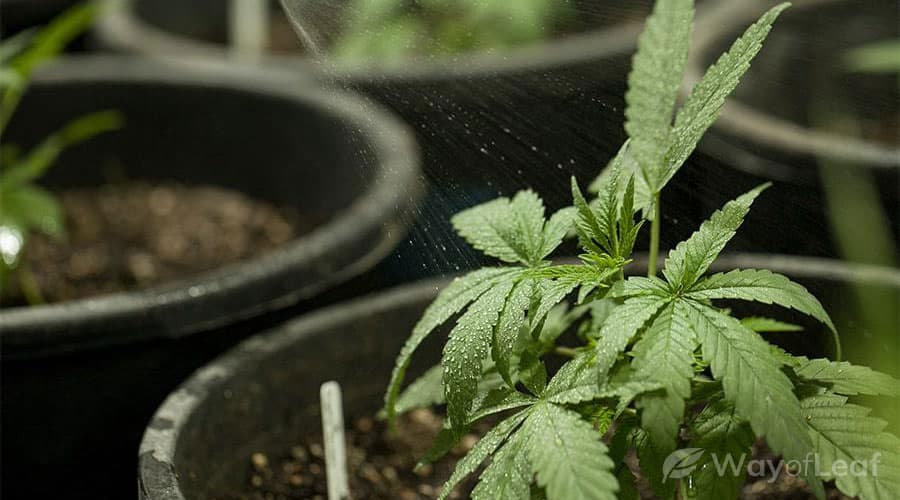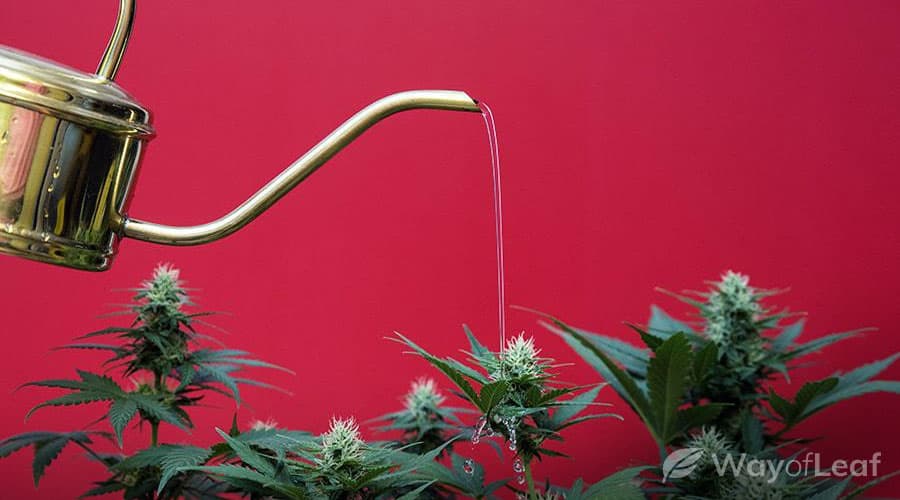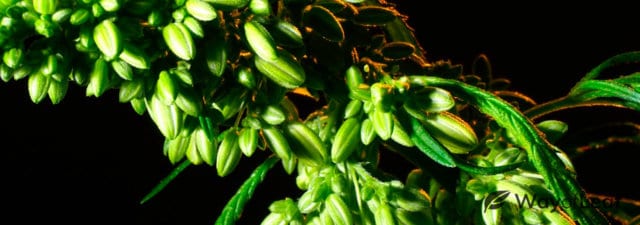As marijuana is a plant, it needs water, nutrients, sunlight, and air to grow. Although it is traditional to use soil as a growing medium, there are a myriad of alternatives on the market. However, no matter the medium, proper hydration is the be-all and end-all of successful marijuana plant growth. It is especially the case since it consists of 80% water!
Too many new growers make the mistake of believing that watering their plants is an easy process. The main crime against weed plants is overwatering. For some reason, newbies also tend to think it is essential to saturate their crops. If you add too much water, you run the risk of obstructing your crop’s oxygen intake. But if you under-water your plants, they get thirsty, and their leaves start to wilt.
An overwatered marijuana plant often has drooping leaves. Unlike wilted plants, the leaves of overwatered plants are so saturated with water that they curl in on themselves. Remember, your weed uses its root systems to breathe air. When you flood these roots, you’re in danger of drowning the unfortunate plants. Another sign of overwatering is yellowing leaves.
Spotting an under-watered plant is easy. Such marijuana plants will look weak and lifeless and display clear signs of wilting. In extreme cases, the leaves are brittle and feel like paper when touched. If you have a cannabis garden for the first time, keep reading to learn more about optimal watering strategies.
Best Products for Hydrating Cannabis Gardens
Below, we provide you with a list of useful products that will help you water the plants correctly. They are designed to take the guesswork out of proceedings and reduce the risk of underwatering or overwatering your precious plants. No matter what option you choose, bear in mind that there are different growth cycles. Each of them requires a unique watering schedule.

Here is a quick overview:
- Seedling Stage: To begin with, it is best to water twice a day, but focus on frequency over volume.
- Vegetative Stage: Daily watering works best if you’re using small pots. If you have large containers, switch to watering every two days.
- Flowering Stage: Water every 2-3 days.
As for pot size, you have to choose your container carefully if you wish to hydrate your marijuana plants properly. Common sense tells us that the plant can’t consume all of the water if its roots can’t reach it! If you have a container where the roots don’t reach, you have leftover water. This moisture then becomes a target for root rot, insects, and fungi.
As a rule of thumb, start things off with pots or cubes that are one square inch apiece. As your plants grow, increase the size of the container to four square inches. Eventually, you will need a one-gallon pot, followed by a two-gallon container, and so on. Upgrade the pot each time your plant outgrows it.
Tip #1 – Use Smart Pots
These particular pots are made with canvas to help your marijuana plants’ roots breathe. They also enable water to drain and ensure heat escapes. Smart Pots are a prevalent option amongst indoor growers. Some users point out that they tend to dry out faster than with standard containers because the air passes through them. Once you get used to this adjustment, you’ll thoroughly enjoy using Smart Pots.
Tip #2 – Employ a Drip Line System
If you have a large crop or are gardening in a hot climate, a drip line system could be a lifesaver. It enables you to water your plants and distribute the liquid consistently and evenly across the container. Let’s say you use Perlite and overwater your pot. You will find that the volcanic glass rises to the surface, where it loses its effectiveness.
As a bonus, controlling the frequency of watering and the volume of water you add helps you manage nutrient supply. A proper drip system will include a series of small tubes and droppers. These connect your water supply to each plant in your garden.
Tip #3 – Add Perlite
Although this heat-treated volcanic glass is an exotic material, it is becoming increasingly popular in marijuana-growing circles. It is typically added to growing mediums because it improves the structure of organic soils. As it is a neutral substance, it doesn’t impact the pH of your water or nutrient EC.
When you heat this natural substance over 1,400 degrees Fahrenheit, it expands enormously to become Perlite, a commercial material. You will notice how white it looks, and you can purchase it in fine, medium, and coarse grades. If you use a lot of nutrients in your plants, add up to 50% perlite. Reduce to 20% if you don’t plan to add a massive amount of additives and nutrients.
Tip #4 – Invest in a Timer
If you use a drip line system, you automatically use a timer. This reduces the amount of work you need to put in because the system waters the plants on a schedule and controls how much water you use. Once you have a system with a timer, it ensures your marijuana plants are well taken care of. You can even leave the state and allow your timer to do its thing.
Tip #5 – Look at Other Auto-watering Cannabis Systems
We have already mentioned the drip line system, which is a form of auto-watering cannabis plants. It is difficult to emphasize how much time and stress one of these systems will save you. It is only when you attempt to water manually that you genuinely understand.
Aside from the drip irrigation option, you can also choose sprinkler irrigation. Once again, it is activated when scheduled. Instead of providing water to each pot individually, a sprinkler system disperses water across all plants.
It would be remiss to suggest that auto-watering cannabis systems are foolproof or free from disadvantages. They aren’t especially easy to set up, and such a system could prove excessively expensive for small home growers. If you use a drip system in particular, you have to check and clean the pipes regularly to stop clogging. Otherwise, you risk allowing mineral and algae build-up, which may result in hampered water flow.
Also, if your system dispenses the water beneath the soil, you won’t know if it is feeding your plants properly. If there is a problem, you won’t notice it for several days until your plants start showing signs of distress. Finally, you can’t merely set up your system and leave your crop alone for days on end. Regular checks for signs of disease or ill health are essential.
How Often Should You Water Cannabis Plants to Benefit from Good Buds?
We offered some very generic outlines of how often you should water your seedlings, along with plants in their vegetative and flowering stages. However, there is no ‘hard and fast’ rule. Everything depends on the climate, type of strain, the growing medium you use, and whether you’re growing indoors or outdoors.
Overall, it is a ‘safe bet’ to water your plants a little. Ideally, you’ll reach the point where you soak the pot with a little bit of runoff. While the water should remain on the surface briefly, it needs to drain into the growing medium relatively quickly. Next, you have to monitor your plants carefully and look for signs of underwatering or overwatering.
As for when to water your plant next, experts agree. They say that when you use soil, you should water the plants once the first couple of inches of soil feels dry. Another telltale sign is if the container feels exceptionally light. Are you adding nutrients to the water regularly? If so, add enough water to get up to 20% of the runoff that drains out of the container’s bottom. This process prevents a build-up in your soil.
Experience Helps
When you know about checking the soil regularly, you should get a feel for how often you need to water. You also learn more about the volume of water required. Water the marijuana plants at the first sign of the leaves wilting.
Many new growers rely on their trusty watering can. This isn’t a bad option when you only have a handful of cannabis plants to worry about. However, once you have a substantial garden, your can is too small to fulfill the demand for water. You can persist, but it will involve multiple refills.

An increasing number of cultivators are investing in devices such as Battery-Operated Liquid Transfer Pumps. These pumps enable you to pump water from a large container to your weed. The most popular options are capable of reaching the bottom of a 3-gallon jug.
When watering weed, there are some other considerations.
pH Monitoring
Even if you get the watering process correct, a low-quality water source could undo all of your hard work. The pH scale runs from 0 – 14 and determines how acidic or alkaline a substance is. 7.0 is considered neutral, and clean water’s pH is in and around that mark. The pH of water dictates your plant’s capacity to absorb nutrients. For the record, 0 – 6.9 is acidic, while everything from 7.1+ is alkaline.
Through trial and error, growers have determined that marijuana plants grow best at a pH of around 6.5. You can measure pH by adding a pH meter to a sample of water runoff. This is ideal because runoff water has passed through your grow medium and drains from the container. If the pH is too high or low, you need to purchase a particular product. The goal is to ensure it is as close to 6.5 as possible.
Parts Per Million (PPM)
PPM measures the number of minerals dissolved into your water source. For instance, a reading of 115ppm means there is 115 milligrams per liter of minerals present in your source. During the vegetative stage, the ideal PPM is 500 while it rises to 1,000 during the flowering stage. Invest in a TDS meter. It measures the water source’s PPM and ensures your plants are not receiving too few or too many nutrients.
Water Quality
Unfortunately, you may live in an area where the water quality is compromised (Flint, Michigan, anyone?) If this is the case, the water you use on your plants may contain bacteria and other pollutants. These unwanted additions could contaminate the water. Trying to grow plants in these circumstances will only lead to disaster.
To prevent a catastrophe and the waste of countless hours, money, and energy, invest in a reverse osmosis (RO) filter. These filters remove up to 99% of dissolved salts from the water, resulting in the cleanest possible end product for your marijuana plants.
Conclusion: Watering Cannabis Plants
If you have never grown marijuana plants before, you will be shocked at how much effort goes into the process. It isn’t just a case of planting them, adding nutrients, and watering as and when you feel like it. There are a range of details to consider if you want a strong and healthy crop.
Watering your marijuana plants is the most crucial consideration. However, it isn’t as easy as getting a watering can and using it like you would with a bunch of roses. When choosing a watering schedule, you have to adjust depending on whether you grow indoors or outdoors. Climate considerations are also of paramount importance since heat and humidity have a significant impact on cannabis plants.
Finally, you have to consider your growing medium. If you have a small garden, manual watering with a traditional watering can is fine. If you have a more extensive operation, it is worth investing in an auto-watering cannabis system. It will help take the stress out of matters. When all else fails, the weight of your pots can serve as a useful watering guide.
If they are cumbersome, it means the soil is too wet, and you should wait for a few days. If they are too light, it is time to water them immediately. This is especially true if the plant’s leaves are showing signs of wilting.
![Who Grows the Best Weed in California? [We Reveal the Truth]](https://wayofleaf.com/wp-content/uploads/2018/07/mj_who-grows-the-best-weed-in-california-answered-640x225.jpg)



![The Many Colors of Weed [Complete Guide]](https://wayofleaf.com/wp-content/uploads/2018/12/mj_the-colors-of-cannabis-guide-640x225.jpg)



![Growing Sweet Sinsemilla Bud [The Ultimate Guide]](https://wayofleaf.com/wp-content/uploads/2018/08/wol_growing-sweet-sensimilla-bud-640x225.jpg)



